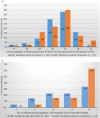Ultrasonographic-based predictive factors influencing successful return to racing after superficial digital flexor tendon injuries in flat racehorses: A retrospective cohort study in 469 Thoroughbred racehorses in Hong Kong
- PMID: 29352495
- PMCID: PMC6099230
- DOI: 10.1111/evj.12810
Ultrasonographic-based predictive factors influencing successful return to racing after superficial digital flexor tendon injuries in flat racehorses: A retrospective cohort study in 469 Thoroughbred racehorses in Hong Kong
Abstract
Background: Superficial digital flexor tendon (SDFT) injury is an important health and welfare concern in racehorses. It is generally diagnosed with ultrasonography, but predictive ultrasonographic features have not been reported.
Objectives: To determine ultrasonographic features of forelimb SDFT injury at initial presentation in Thoroughbred racehorses that could predict a successful return to racing (completing ≥5 races).
Study design: Retrospective cohort study.
Methods: Digitised ultrasonographic images of 469 horses with forelimb SDFT injuries from the Hong Kong Jockey Club (2003-2014) were evaluated, using a previously validated ultrasonographic scoring system. Six ultrasonographic parameters were evaluated (type and extent of the injury, location, echogenicity, cross-sectional area and longitudinal fibre pattern of the maximal injury zone [MIZ]), as well as horse signalment, retirement date and number of races before and after injury. Data were analysed by generalised linear regression with significance at P<0.05.
Results: Cases were divided into two groups: 1) For cases of SDFT tendonitis with core lesions, cross-sectional area at the MIZ was the most significant factor determining a successful return to racing (P = 0.03). If the lesion was <50% of the total cross-sectional area, horses had 29-35% probability of successfully racing again, but if it was ≥50% this decreased to 11-16%. 2) For cases of SDFT tendonitis without a core lesion, longitudinal fibre pattern at the MIZ best predicted a successful return to racing (P = 0.002); if the affected longitudinal fibre pattern was <75% of the total, horses had 49-99% probability of successfully return to racing, but if it was ≥75% this decreased to 14%.
Main limitations: Prognostic information may not be applicable to other breeds/disciplines.
Conclusions: This is the first study to describe ultrasonographic features of forelimb SDFT injuries at initial presentation that were predictive of successful return to racing. The outcomes will assist with early, evidence-based decisions on prognosis in Thoroughbred racehorses.
Keywords: SDFT; horse; predictive factors; tendinopathy; ultrasonography.
© 2018 The Authors. Equine Veterinary Journal published by John Wiley & Sons Ltd on behalf of EVJ Ltd.
Figures



Similar articles
-
A retrospective cohort study investigating risk factors for the failure of Thoroughbred racehorses to return to racing after superficial digital flexor tendon injury.Vet J. 2018 May;235:42-46. doi: 10.1016/j.tvjl.2018.03.003. Epub 2018 Mar 14. Vet J. 2018. PMID: 29704937
-
Prevalence of superficial digital flexor tendonitis and suspensory desmitis in Japanese Thoroughbred flat racehorses in 1999.Equine Vet J. 2004 May;36(4):346-50. doi: 10.2746/0425164044890580. Equine Vet J. 2004. PMID: 15163043
-
Parameters influencing prevalence and outcome of tendonitis in Thoroughbred and Arabian racehorses.Pol J Vet Sci. 2012;15(1):111-8. doi: 10.2478/v10181-011-0121-9. Pol J Vet Sci. 2012. PMID: 22708365
-
Clinical experience with quantitative analysis of superficial digital flexor tendon injuries in Thoroughbred and Standardbred racehorses.Vet Clin North Am Equine Pract. 1990 Apr;6(1):129-45. doi: 10.1016/s0749-0739(17)30560-6. Vet Clin North Am Equine Pract. 1990. PMID: 2187567 Review.
-
A review of tendon injury: why is the equine superficial digital flexor tendon most at risk?Equine Vet J. 2010 Mar;42(2):174-80. doi: 10.2746/042516409X480395. Equine Vet J. 2010. PMID: 20156256 Review.
Cited by
-
A Preliminary Investigation into Ridden Water Submersion Training as an Adjunct to Current Condition Training Protocols in Performance Horses.Animals (Basel). 2021 Sep 7;11(9):2629. doi: 10.3390/ani11092629. Animals (Basel). 2021. PMID: 34573594 Free PMC article.
-
Risk factors for superficial digital flexor tendinopathy in Thoroughbred racing horses in Japan.J Equine Sci. 2019;30(4):93-98. doi: 10.1294/jes.30.93. Epub 2019 Dec 18. J Equine Sci. 2019. PMID: 31871411 Free PMC article.
-
Efficacy of Serial Ultrasonographic Examinations in Predicting Return to Play in Agility Dogs with Shoulder Lameness.Animals (Basel). 2021 Dec 30;12(1):78. doi: 10.3390/ani12010078. Animals (Basel). 2021. PMID: 35011184 Free PMC article.
-
Clinical benefits of early-stage autologous conditioned serum and injectable platelet-rich fibrin on healing superficial digital flexor tendonitis in donkeys.Ir Vet J. 2025 Jun 7;78(1):13. doi: 10.1186/s13620-025-00299-y. Ir Vet J. 2025. PMID: 40483508 Free PMC article.
References
-
- Kasashima, Y. , Takahashi, T. , Smith, R.K. , Goodship, A.E. , Kuwano, A. , Ueno, T. and Hirano, S. (2004) Prevalence of superficial digital flexor tendonitis and suspensory desmitis in Japanese Thoroughbred flat racehorses in 1999. Equine Vet. J. 36, 346‐350. - PubMed
-
- Lam, K.H. , Parkin, T.D. , Riggs, C.M. and Morgan, K.L. (2007) Descriptive analysis of retirement of Thoroughbred racehorses due to tendon injuries at the Hong Kong Jockey Club (1992–2004). Equine Vet. J. 39, 143‐148. - PubMed
-
- Goodship, A.E. , Birch, H.L. and Wilson, A.M. (1994) The pathobiology and repair of tendon and ligament injury. Vet. Clin. North. Am. Equine Pract. 10, 323‐349. - PubMed
-
- Rossdale, P.D. , Hopes, R. , Digby, N.J. and Offord, K. (1985) Epidemiological study of wastage among racehorses 1982 and 1983. Vet. Rec. 116, 66‐69. - PubMed
-
- Marr, C.M. , McMillan, I. , Boyd, J.S. , Wright, N.G. and Murray, M. (1993) Ultrasonographic and histopathological findings in equine superficial digital flexor tendon injury. Equine Vet. J. 25, 23‐29. - PubMed
MeSH terms
LinkOut - more resources
Full Text Sources
Other Literature Sources

